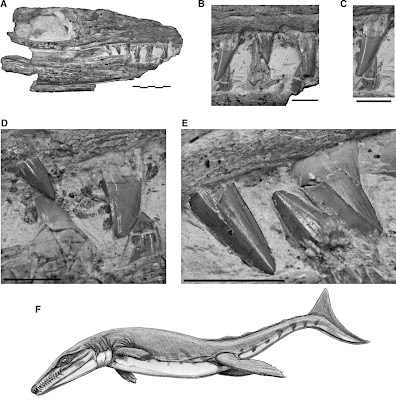
Geosaurus (top) and Dakosaurus (bottom) were mega meat-eaters that rivalled dinosaurs as predators. Art by Dmitry Bogdanov
ABSTRACT
Metriorhynchids were a peculiar group of fully marine Mesozoic crocodylomorphs. The derived genera Dakosaurus and Geosaurus exhibit a macroevolutionary trend towards extreme hypercarnivory, underpinned by a diverse array of craniodental adaptations, including denticulate serrated (ziphodont) dentition. A comparative analysis of serrations in Metriorhynchidae shows that known Dakosaurus species had conspicuous denticles, in contrast to the microscopic denticles of Geosaurus. A new tooth from the Nusplingen Plattenkalk of Germany provides evidence for a previously unknown large species of Geosaurus. Metriorhynchid specimens from the upper Kimmeridgian–lower Tithonian of Southern Germany show that ziphodont species of Dakosaurus and Geosaurus co-occurred in the Nusplingen and Solnhofen Seas. Although these genera are similarly denticulate, they diverge in overall crown morphology. Therefore, resource/niche partitioning via craniodental differentiation is posited as maintaining two contemporaneous genera of highly predatory metriorhynchids. Additionally, the new generic name Torvoneustes is proposed for “Geosaurus” carpenteri, the only known metriorhynchid with false-ziphodont dentition. A cladistic analysis shows that ziphodont dentition may have evolved independently in Dakosaurus and Geosaurus, or been acquired earlier by their common ancestor and secondarily lost in Torvoneustes and related taxa.
FIGURE 1 Dentition in Geosaurus giganteus, as seen in NHM R.1229, type specimen. A, General aspect of skull. B–C, Detail of teeth at mid-dentition, at the right side, showing the occlusion pattern and general crown morphology. D, Oblique view of crowns at the right side, where it is possible to note the facets and carinae. E, Oblique close up of teeth at the left side, where serrations in the carinae are barely perceptible. F, Life reconstruction of Geosaurus. Solid bar equals 10 mm. Life reconstruction in F by Dmitry Bogdanov.

FIGURE 4 Ziphodont dentition in Dakosaurus maximus. A, General view of the skull and dentition, as seen in SMNS 8203, neotype. B, Close view of NHM 35766, a typical D. maximus crown, used in this study to access carinal morphology. C, BSE microscopy of NHM 35766, showing morphology of carina, in lateral (top) and occlusal (bottom) views, with detail of denticles in occlusal view (right). D, Life reconstruction of Dakosaurus maximus. Note the robustness of denticles. Solid bar in A–B equals 10 mm; graduated bar in C equals 200 μm. Life reconstruction in D by Dmitry Bogdanov.

FIGURE 8 Reduced phylogeny based on Young and Andrade (2009), and including new metriorhyncnid ziphodont teeth. The phylogeny is calibrated with the stratigraphical record, and firmly places SMNS 818384 within Geosaurus. Ziphodont taxa (white squares) may have either microscopic (small squares) or macroscopic (large squares) denticles. Note that ghost lineages extend the range of Geosaurus and Dakosaurus into the early Oxfordian. Currently, Geosaurus is restricted to the Late Jurassic–Early Cretaceous of Europe. Nodal support values as follows: double decay index above 1 (italicized); bootstrap above 50% (bold).
Reference:
Andrade, M.B.D., Young, M.T., Desojo, J.B. and Brusatte, S.L. 2010. The evolution of extreme hypercarnivory in Metriorhynchidae (Mesoeucrocodylia: Thalattosuchia) based on evidence from microscopic denticle morphology. Journal of Vertebrate Paleontology. 30 (5): 1451–1465. dx.doi.org/10.1080/02724634.2010.501442
Underwater T.Rex-Like Carnivores Built to Kill : Discovery News http://t.co/A6RNfe4
• Extinct relatives of crocodiles were mega meat-eaters, with a diet of up to 70 percent flesh.
• Species such as Dakosaurus and Geosaurus evolved sharp, serrated teeth.
• These marine predators could also spin with their teeth sunk in prey, allowing them to take down large beasts.
